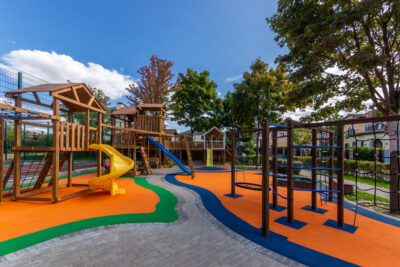The Best Outdoor Playground Features for Nature-Inspired Schools and Community Parks
OutdoorHub Staff 03.26.25

SPONSORED CONTENT
Outdoor playgrounds represent the perfect intersection between structured play and natural exploration. They can be expansive wilderness-inspired spaces or compact nature-themed areas that maximize limited space. Whether featuring rustic wooden structures blending with the landscape or innovative designs that mimic natural formations, the best outdoor playgrounds incorporate elements that connect children with the natural world while providing developmental benefits. Here are the essential features that schools and community parks should consider when installing a new outdoor playground to maximize the connection with nature.

1. Nature-Inclusive Play
Everyone should have the opportunity to experience the outdoors. Nature-inclusive playgrounds offer accessible, adaptable features for children of all physical abilities while incorporating natural elements like logs, boulders, and native plants. These thoughtfully designed spaces promote social inclusion and physical development while encouraging children to form connections with the natural world regardless of ability levels.
Schools and community parks looking to build a nature-inclusive playground should embrace universal design principles within natural settings. This includes adding sensory elements such as textured bark panels, outdoor musical instruments made from sustainable materials, and aromatic native plant gardens. It also means incorporating adaptive equipment, such as specially designed tree swings with harnesses and flexible seating options made from natural materials. Any nature-inspired climbing structures, like artificial rock formations or log climbers, should include strategically placed handrails and accessible paths to ensure all children can experience them. Ground-level spinners or roundabouts with wheelchair access can be nestled among native landscaping to encourage interactive play amongst all children while maintaining the natural aesthetic.
School playground equipment with these types of inclusive, nature-focused features offers children with disabilities the chance to engage in both structured play and natural exploration during recess. When all children are invited to play outdoors together, social bonds form naturally. These thoughtfully designed spaces also increase independence levels, allowing children to navigate and connect with nature as freely as possible. Parents of all children will appreciate the school system’s commitment to equal access to outdoor play experiences.
2. Age-Appropriate Natural Designs
Children’s relationship with nature evolves as they grow! Playgrounds with age-appropriate natural designs encourage physical and cognitive development through different stages while maintaining a connection to the outdoors. For families visiting parks with children of different ages, this means everyone can enjoy age-appropriate nature exploration in the same space.
Nature-inspired age-appropriate designs ensure children are appropriately challenged and stimulated while safely enjoying the outdoors. This means incorporating a range of natural surfaces, such as engineered wood fiber for toddlers, as well as nature-based tactile experiences for all ages. Adding tree-inspired handholds to climbing structures helps younger children develop confidence in navigating natural spaces.
For school-aged children, schools and parks can incorporate taller boulder climbers, tree-house inspired platforms, log balance courses, and natural material equipment that develops both motor skills and comfort in outdoor settings. Adventure elements like nature-themed zip lines, tire swings suspended from timber frames, forest-inspired rope courses, and climbing nets designed to mimic spider webs provide dynamic opportunities to build physical coordination while fostering an appreciation for outdoor adventure. Areas designed for older children exploring more challenging natural elements may need natural boundaries like boulder arrangements or living willow fences to create separate exploration zones for different age groups.
3. Weather-Resistant Durability and Outdoor Safety
Schools and community parks investing in a new outdoor playground must prioritize weather resistance and safety measures appropriate for outdoor environments. Durable, safe playgrounds promote physical development while ensuring children can explore freely in all seasons.
Weather-resistant equipment means the playground will withstand various outdoor elements year-round. The specific needs will vary based on geographical location and climate conditions. Playgrounds in coastal areas require salt-resistant materials, while those in northern regions need freeze-thaw durability. Most outdoor playgrounds should include equipment that’s resistant to UV damage, moisture penetration, temperature fluctuations, and fungal growth. Natural materials should be properly treated for outdoor use, and all equipment should be secured against high winds common in open park settings. These considerations ensure the playground remains safe and functional through changing seasons.
For outdoor safety, consider the natural landscape and environment in your design layout. Equipment should be strategically placed to take advantage of natural wind patterns and sun exposure while allowing enough space for movement. Industry standards recommend at least six feet of unobstructed space around each structure, with additional clearance for areas near water features or natural inclines. Slides should be positioned away from strong afternoon sun exposure and away from ground-level equipment like spinners. Surfacing materials should be selected based on the regional climate, with proper drainage for rainy areas and heat-reflective options for hot climates. Always consult local outdoor recreation safety regulations, as requirements may vary based on wilderness proximity, wildlife considerations, and environmental factors specific to your region.
4. Environmental Integration: Shade, Natural Seating, and Eco-Friendly Facilities
Thoughtful environmental integration through natural shade, seating, and eco-friendly facilities makes outdoor playgrounds comfortable and sustainable. For schools where recess often occurs during peak sun hours, a combination of strategically planted native shade trees and sustainable shade structures protects children while enhancing the natural setting. These natural shade solutions not only cool playing children but prevent equipment from overheating and reduce UV exposure.
Natural seating areas created from logs, boulders, or other sustainable materials provide resting spots for children who need a break from active play while encouraging nature observation. In community parks, natural seating areas positioned near play zones allow parents and caregivers to comfortably supervise while enjoying the outdoor setting. These gathering spaces foster community connections and provide opportunities for outdoor education.
Eco-friendly restroom facilities with composting toilets, rain collection systems, and native plant landscaping demonstrate environmental stewardship while providing necessary amenities. Adding educational signage about local wildlife, plant identification, or conservation efforts transforms functional areas into learning opportunities about the natural world.
5. Seasonal Adaptability and Weather Engagement
The best outdoor playgrounds embrace seasonal changes rather than fighting against them. Incorporating features that showcase seasonal weather patterns and natural cycles creates year-round interest and educational opportunities. Rain gardens with proper drainage capture precipitation and demonstrate water cycles while supporting native plant species. Winter-friendly equipment designed to be safely used in snowy conditions extends outdoor play through colder months. Natural materials that display seasonal changes—like deciduous trees that provide summer shade and allow winter sun—create dynamic spaces that evolve throughout the year.
Conclusion
When designing an outdoor playground, consider both the users and the natural environment. For schools, this means creating spaces where children can grow alongside seasonal changes and develop a comfort with the outdoors. The playground should accommodate various ages and grades while incorporating natural learning opportunities. For community parks, weather-resistant durability, environmental sustainability, and connecting visitors with natural surroundings should be priorities. By thoughtfully implementing these nature-inspired features, you’ll create an outdoor playground that fosters both physical development and a lifelong appreciation for the natural world.

